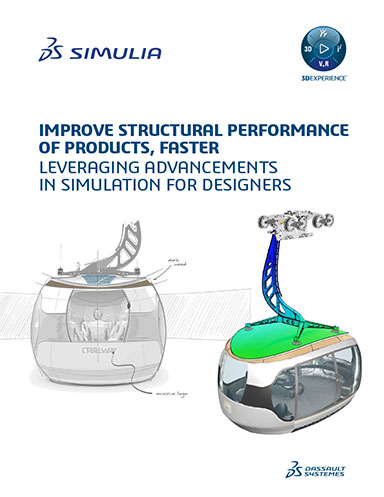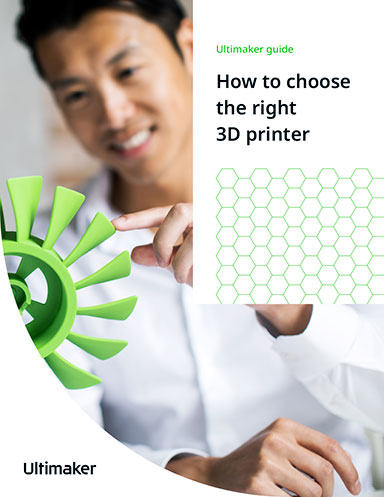Materialise Summit Expounds on Next 3D Printing Frontier
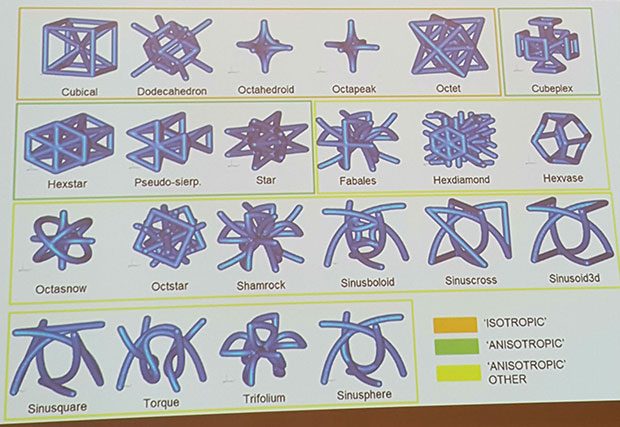
One line of research at Materialise is how materials can be made more energy absorbing by modifying shape at the voxel level. Image courtesy of a presentation by Materialise.
Latest News
May 2, 2017
For 20 years most discussions around 3D printing have been about its use in prototyping. By contrast, the presentations and discussions at the recent Materialise World Summit in Brussels were about the disruption of all engineering and manufacturing processes, from initial design consideration to final part or product delivery.
Like the proverbial blind men and the elephant, the main stage presenters all described the new processes of additive manufacturing from their own specific frame of reference. All saw disruption of processes as the central theme of 3D printing for the next few years. (The terms “additive manufacturing” [AM] and “3D printing” were used interchangeably during the conference). More than 600 attendees listened to 50+ speakers from leading industrial and medical organizations, including Siemens, BASF, GE, Airbus, GKN, HOYA, Atos, SAP, Safilo, Mayo Clinic, Geisinger Health System, Johnson & Johnson and others. In addition, two panel discussions were organized to allow industry experts to address the future of the technology.
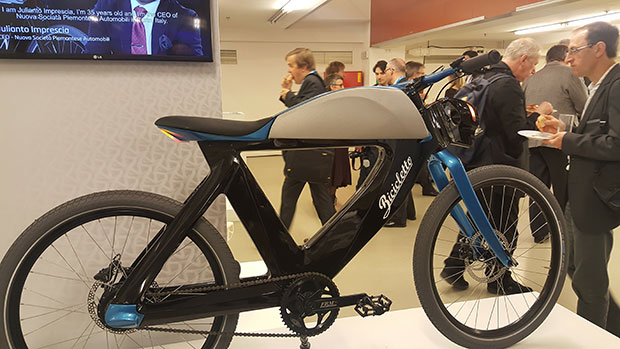 For generations Italy’s Nuova SPA produced automotive classics, then focuses on bicycles. Bicicletto is an electric bike designed with the aesthetics of a vintage model. By designing for partial production using 3D printing, Nuova was able to reduce total weight and cut production costs. Image courtesy of Materialise.
For generations Italy’s Nuova SPA produced automotive classics, then focuses on bicycles. Bicicletto is an electric bike designed with the aesthetics of a vintage model. By designing for partial production using 3D printing, Nuova was able to reduce total weight and cut production costs. Image courtesy of Materialise.The chemistry viewpoint was one of many frames of reference. “Additive manufacturing (AM) is truly different from classical materials processing,” says Volker Hammers, managing director in Germany for chemical giant BASF. “AM means design and process are as important as material properties.” In the past additive manufacturing processes were about managing risks through over-engineering and coping with limited materials, Hammers says. “[Today] AM is a journey; the steps from rapid design prototyping to industrial manufacturing of functional parts is strongly underestimated.”
In 2015 state of the art was rapid design prototyping, individualized medical uses and rapid tooling. Hammers says there is unmet need in the marketplace today for certified quality, cost reduction, improved surface resolution, higher material performance, open systems and more choices. There is still “too much protectionism” in the 3D printing marketplace, says Hammers.
Looking ahead, by 2020 Hammers believes state of the art in additive manufacturing will be rapid functional prototyping and small-series production from 3D designs. Small but fast-growing applications in 2020 will include spare parts on demand and plastic parts with integrated functionality (such as built-in circuits.) By 2020 BASF believes the market for 3D printing materials will be $3 billion, having grown at a compound annual growth rate of 30% between 2015 and 2020. Hammers says BASF also believes 2020 will bring value chain disruptions, performance on the voxel level, in-line chemistry, certified digital manufacturing and a lack of skilled labor.
Pushing process innovation at Airbus
Aeronautics was an early and enthusiastic user of 3D printing technologies. Airbus is now working to move from “advanced prototyping” to serial processes that include “improved process robustness, sensible process monitoring, and better surface quality of as-built parts,” says Andre Walter, head of Site & Plant for Airbus Bremen. Airbus intends to push additive manufacturing processes in design and manufacturing. Current design initiatives include developing “manufacturing-friendly” fuselage structure design concepts, and new lightweight designs for existing parts. For manufacturing, current initiatives include development of advanced low-cost processes, new assembly processes and increased production robustness.
 One line of research at Materialise is how materials can be made more energy absorbing by modifying shape at the voxel level. Image courtesy of a presentation by Materialise.
One line of research at Materialise is how materials can be made more energy absorbing by modifying shape at the voxel level. Image courtesy of a presentation by Materialise.The real challenge in process innovation is the creation of a digital supply chain, says Materialise VP of Software Stefaan Matte. “Innovation is important; we need to innovate more. But it’s not the core challenge.” What is? The digital supply chain. “Looking beyond software and machines but to the applications where 3D technology needs to live.” Acknowledging the 40% of attendees who were in an adjacent hall in the Healthcare track, Matte used the rapid growth of 3D printing in medicine as an example of innovation that redefines traditional processes. “Designing a surgical guide for a perfect fit doesn’t make it a success. The success lies in reaching out to the hospital in the first place.”
The idea of a digital supply chain rooted in additive manufacturing is also a goal for Deutsche Bahn AG. Not only is Deutsche Bahn the national railroad of Germany, it is a leading global provider of rail vehicle and infrastructure maintenance through its wholly owned subsidiary DB Vehicle Maintenance (DBVM). Two years ago DBVM started looking at how to incorporate additive manufacturing into its business. Providing spare parts is the single biggest issue in its services business, says DBVM CEO Uwe Fresenborg. “We are still supporting 100-year-old steam locomotives as well as as the newest high-speed electric engines.” One time early after acquiring metal 3D printing capabilities, DBVM was told by a provider it would take six months to deliver a part, so Fresenborg turned to his 3D printing group. They turned the job around in two weeks.
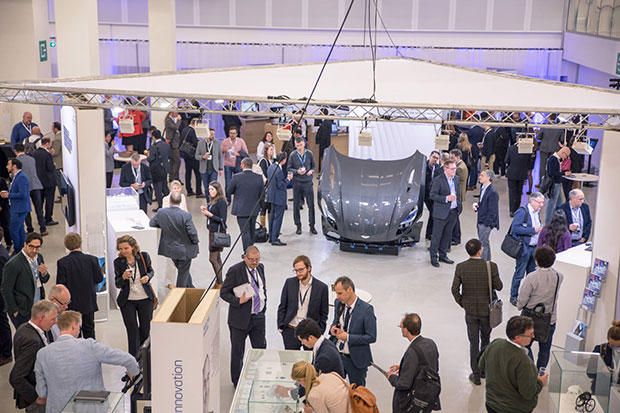 There were long breaks between presentation sessions at Materialise World Summit, providing extended opportunities for networking. Image courtesy of Materialise.
There were long breaks between presentation sessions at Materialise World Summit, providing extended opportunities for networking. Image courtesy of Materialise.Fresenborg intends for such disruptive service innovation to be the new normal in a digital supply chain. His group created 10 parts in 2015, 1,000 in 2016 and are on pace to 3D print 4,000 parts in 2017. The goal is to station printers globally, “to disrupt ... the existing industrial footprint,” says Fresenborg. “We want to transport powder not parts.” The motto of DBVM is now “mobility goes additive,” with a website to support its new vision and to recruit industry partners. The ultimate goal, Fresenborg says, is to “change the business model to support rail propulsion as a service.”
“The race to end-to-end digital systems is on,” says Stefaan Motte, the VP of software for Materialise. Although there are many competitors, and it is “A” race, Motte says it is not “THE” race. “The race is 3D printing versus traditional make industries. We must keep making advancements and run this race together. We are still the new kids on the block.”
Alexander De Croo brought an unusual perspective to the Materialise World Summit. He is vice prime minister of Belgium, and was named a “New Young Leader” at the recent World Economic Forum in Davos, Switzerland. He is an outspoken advocate of innovation as a driving economic force. “We’ve been looking at the future as a frightening case of man versus machine. That’s not the case. Yes, technology has destroyed jobs—poorly paid, back-breaking, unengaging jobs. And it has replaced them with better paid, intellectually stimulating jobs.” Echoing a need cited by others at the summit, De Croo says governments need to increase educational opportunities in 3D printing.
The healthcare angle
Materialise has grown from being a small rapid prototyping service bureau with one 3D printer to a major player in software development, engineering research and one of the world’s largest 3D printing service bureaus. One of its largest research tracks is in health care; nearly half of the delegates attending the conference were there for the medical sessions. Attendees in the manufacturing track got introduced to what the other side of the house was discussing in a presentation from Dr. Jonathan Morris, a physician at the world-famous Mayo Clinic in Rochester, MN, and a leading proponent of 3D printing models for surgical preparation. When the clinic took on the challenge of separating conjoined twins, all the digital data from computerized tomography scans and MRIs were assembled into a 3D model and printed. “The more we gave them as models, the more they stopped looking at data and gathered around the models,” notes Morris. “There were four teams of surgeons, all talking about different aspects of the surgery, but they all talked about the model. They are used to working on 3D objects; 3D printing bridges the gap in surgery.”
Working directly with research partners is part of the Materialise business model, not just in industry but also in academia and medicine. Ayishwariya Menon is a Materialise program manager for health care in Michigan, where she works closely with researchers from the University of Michigan as well as simulation software maker Altair and 3D engineering processes expert Renishaw. “This ecosystem fuels innovation. We cherish this collaboration.” Adds Manual Michiels, a business innovation specialist at the Materialise Brussels office, “Isolation is an illusion; we look for golden opportunities where we can add value ... innovation is not linear.”
Co-creation for business transformation
“Co-creation” was a theme for the summit. Eyewear specialist Yuniku explained how it uses a co-creation process to drive innovation. Four transformations shape the co-creation process, says Felix S. España, with Yuniku technology partner Hoya Vision Care: product innovation; business model innovation; operational innovation and customer experience.
“We can create a unique value proposition when we combine all three, says España. “We want to do to eyewear what iTunes did to music ... we can change the relationships between customers, optometrists and manufacturers.” Yuniku is now shipping what they call “vision-centric” tailored eyewear, 3D printed from scan data and the prescription. The process replaces the need for an inventory of frames at every optometry office. Designer frames are 3D printed based on how the lenses need to sit on the face of each patient. “This is vision-centric design, not a frame-centric approach anymore,” says España.
 Glasses from Yuniku and other manufacturers of 3D printed eyewear on display at Materialise World Summit 2017. Image courtesy of Materialise.
Glasses from Yuniku and other manufacturers of 3D printed eyewear on display at Materialise World Summit 2017. Image courtesy of Materialise.In a comment to the press after the Summit ended, Peter Leys, executive chairman of Materialise, reflected on how far the industry has come. “I was amazed by the change in mindset in evidence during the presentations and in the discussions being held between. Instead of talking about the technical potential of AM, people were discussing the reality of what they were already achieving and debating the actions needed to further accelerate progress in the industry. It was especially encouraging to see how strongly both the speakers and attendees were already embracing collaboration as a key to creating ecosystems in which meaningful applications of AM can thrive.”
More info:
Subscribe to our FREE magazine, FREE email newsletters or both!
Latest News
About the Author
Randall S. Newton is principal analyst at Consilia Vektor, covering engineering technology. He has been part of the computer graphics industry in a variety of roles since 1985.
Follow DE




